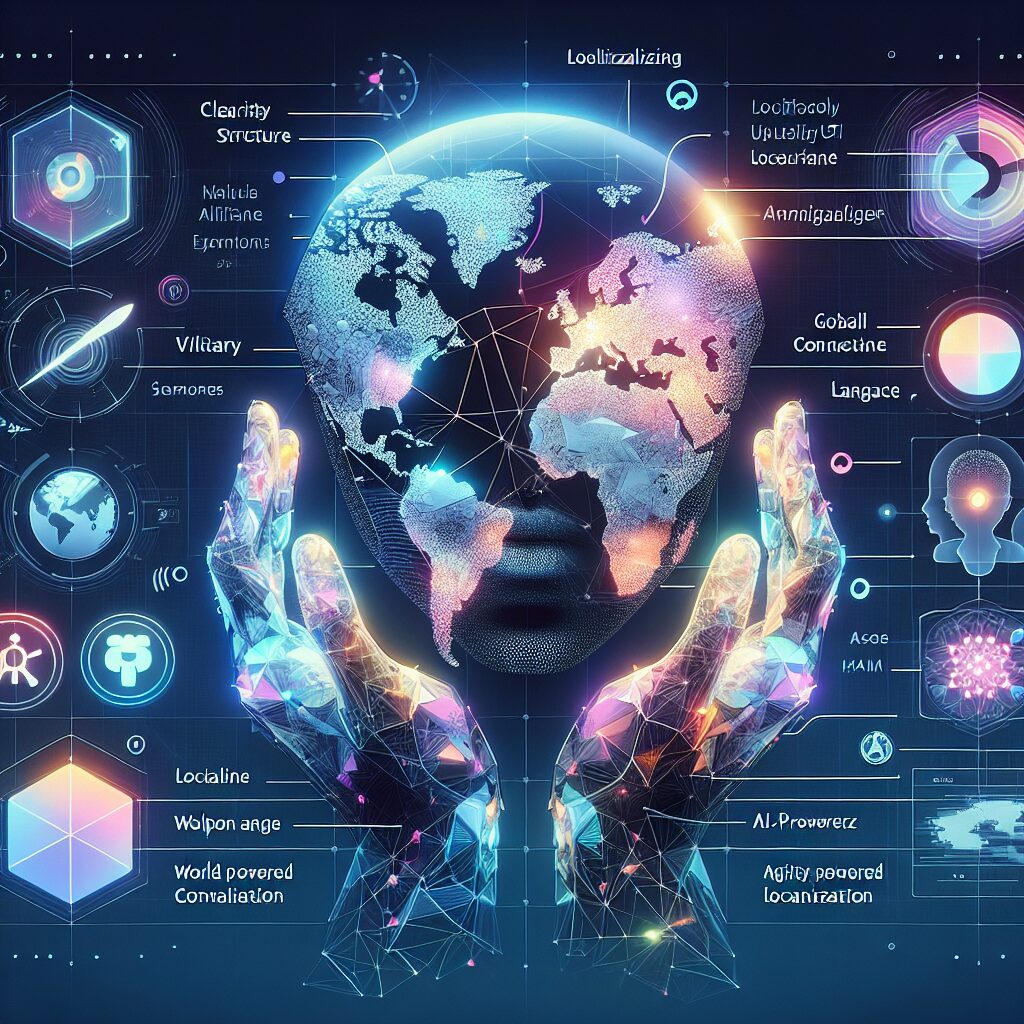About eldris
At Eldris, we automate SEO, multilingual site expansion, and EU compliance for brands scaling across Europe. Our AI-powered platform handles everything from content publishing to regulatory docs—so you don’t have to.
In This Article
- AI and machine learning are central to effective localisation tactics.
- Post-editing workflows maximise translation quality and scalability.
- SEO localisation must be done with native context in mind.
- UX localisation is equally critical as linguistic adaptation.
- Advanced tools and automation fuel productivity in localisation workflows.
- Cultural intelligence is essential to avoid missteps in new markets.
Key Drivers Shaping Localization in 2025
AI, Automation, and Cultural Intelligence
The dynamics of digital expansion are rapidly transforming, and site localization trends 2025 are heavily influenced by groundbreaking integrations of artificial intelligence, sophisticated automation tools, and enriched cultural intelligence frameworks. In previous years, localisation was often seen as a linear process—translate the content and adapt visuals where necessary. However, in 2025, the drivers of localisation success have become multifaceted.
AI fuels predictive localisation decisions, using machine learning algorithms to anticipate language variants, cultural context needs, and even user engagement probabilities. Platforms can now detect trending keywords in real-time across global search engines and recommend locale-specific phrasing accordingly. Automation processes have only enhanced this capability by enabling seamless deployment of updates across dozens of regional sites simultaneously.
Meanwhile, cultural intelligence—the ability to understand and integrate subtle socio-cultural norms into web design, colour schemes, navigation logic, and tone of voice—has become non-negotiable. Businesses now rely on cultural consultants and nuanced sentiment analytics to ensure they are not merely language-compliant, but also contextually resonant with local audiences.

Impact of AI on Translation Quality and Speed
From Neural Networks to Real-Time Adaptation
Artificial intelligence continues to redefine what is possible in the localisation landscape. One of the core site localization trends 2025 is the integration of enhanced neural machine translation (NMT) technology. NMT engines have evolved significantly over the past few years, enabling radically improved accuracy in syntax, grammar, and, most critically, contextual tone.
In 2025, real-time adaptation is a standard expectation. Translation systems now learn on the fly, incorporating user interactions and click behaviour to dynamically improve upcoming translations. For instance, if a call-to-action performs poorly in a local market, AI tools are prompted to test alternatives that might resonate better, leading to immediate user experience improvements.
“AI-driven localisation isn’t just about speed—it’s about intelligent adaptability to every nuance of global markets.”
Machine Translation Post-Editing: Human + AI
The rise of Hybrid Localisation Teams—where linguists and AI tools collaborate—is another cornerstone of the site localization trends 2025. While AI translates content swiftly and at scale, human editors ensure stylistic quality, proper idiomatic usage, and compliance with brand voice guidelines. The synergy of human creativity and machine efficiency is transforming quality outcomes across industries.
This Machine Translation Post-Editing (MTPE) model is particularly beneficial in highly nuanced sectors such as healthcare, legal services, and finance. These industries demand both speed and absolute precision. Editors work closely with AI translation outputs to ensure that region-specific legal terminologies, tone standards, and interaction models are observed and respected.
Platforms now use post-editing productivity metrics to streamline workflows, optimising both human labour and algorithmic learning pathways for continuous improvement. Many organisations, including those discussed in Learn more about Multilingual Website Localization, have begun investing in bespoke MTPE training for their localisation departments.
Personalization at Scale Through Localization
In 2025, one of the most powerful site localization trends involves leveraging site localisation as a dynamic personalisation engine. Consumers expect hyper-relevant content, and localisation plays a central role in meeting that demand. Through advanced segmentation algorithms, content can now be localised not only by geography but also by cultural attitudes, brand affinities, and even device usage patterns.
Retailers, for example, use localisation software to push adjusted offers based on climate-related purchasing behaviours. A user browsing from Paris in December may see different imagery, tone, and pricing structures than one in Buenos Aires, despite viewing the same brand landing page. This level of granular personalisation drives both conversion rates and user trust.
The key is not simply the translation but the bespoke tailoring of the entire site experience to match local expectation nuances. This transformation is made possible through automated A/B testing, integrated CRM data pipelines, and AI-led content labelling systems. The demand for advanced personalisation is directly fuelling investment in localisation automation in 2025.
SEO Strategies for Multilingual Website Success
Localised content also requires intelligent SEO strategy. Among the more technical site localization trends 2025 is the need for strategic alignment between localisation teams and SEO professionals. Many Western businesses have learned the hard way that mere keyword translation is not sufficient to rank competitively in foreign markets.
Local search engines such as Baidu or Yandex follow different ranking parameters than Google. Therefore, effective site localisation also involves native-level keyword research, organic link-building within local networks, and adapting metadata to appeal to region-specific platforms. For more guidance on crafting multilingual SEO frameworks, see Read a related article.
Furthermore, voice search localisation is gaining prominence. As more users across Asia and Latin America search voice-first, localised long-tail query structures must be optimised accordingly. Again, AI is empowering teams to discover and implement high-performing phrases tailored to user habits in diverse linguistic zones.
Best Practices for Localizing User Experiences
Beyond textual content, user interfaces and interaction design are increasingly subject to localisation requirements. Typography choices, site navigation flow, form field structures, and iconography all vary culture-to-culture. One of the defining site localization trends 2025 is this expansion into holistic UX localisation.
For instance, websites targeting Middle Eastern audiences are optimised right-to-left, while those in East Asia often favour less white space and denser layout aesthetics. Cart abandonment rates can also be correlated with checkout flow localisation success or failure.
The best practice is to treat localisation as a UX principle rather than a post-development add-on. Global companies are deploying bi-regional UX and localisation teams, ensuring that prototypes are culturally vetted before launch. Global usability testing, combined with region-specific accessibility audits, provides a solid framework for such initiatives.
New Tools Transforming Localization Workflows
The site localization trends 2025 wouldn’t be complete without discussing the revolutionary tools fuelling these changes. Cloud-based localisation suites now integrate translation management, content deployment, and performance analytics into a unified dashboard. Leading systems offer automated version control, terminology database syncing, and real-time crowd-sourced feedback loops.
Collaborative translation environments are also becoming popular, allowing real-time simultaneous input from multiple stakeholders—linguists, marketers, compliance officers—all within one interface. Platform integrations with CMSs, CRMs, and analytical tools reduce friction between content creation and international deployment.
Moreover, voice-to-text localisation engines, particularly for dynamic multimedia content, are enabling faster transcreation experiences. For an updated list of cutting-edge localisation platforms, Language industry trends shaping 2025 provides an excellent overview of market options.
Top Trends in Content Automation for Global Brands
Automation is no longer limited to backend process management. In 2025, we see a surge in content generation and localisation automation. Global enterprises are deploying generative AI to create region-speific product descriptions, blog posts, and even customer service interactions without human intervention—while still maintaining brand consistency.
The interplay between localisation and automation leads to improved turnaround time and lower costs. However, controls are critical. Meta-linguistic parameters, tone constraints, and vocab filters are used to prevent brand dilutions or cultural mishaps. Personalisation algorithms also draw from past campaign results to distinguish which content types perform best in specific markets, fuelling future automation cycles.
The continuing growth of modular content frameworks—where components like calls-to-action, headers, and descriptions are assembled algorithmically—puts even more pressure on localisation teams to ensure quality within compressed production timelines. Nonetheless, automation remains key to staying competitive in global digital ecosystems.
Challenges in Local Market Penetration
Despite all the advancements, several challenges still restrict flawless localisation. Regulatory complexity in markets like the European Union or data sovereignty laws in nations such as India require brands to tread carefully. These constraints affect how localised content is stored, displayed, and tracked.
There is also the risk of ‘over-localisation’, where excessive adaptation leads to fragmented brand identity. Finding balance between local authenticity and global brand consistency is vital. Furthermore, budget allocations are often mismatched with actual market return potential, causing small opportunities to be overfunded and high-growth but culturally complex markets to be under-served.
Supply chain issues can also hinder content relevance. For instance, if a promo page is accurately localised but the product isn’t available locally, customer trust erodes. Thus, cross-functional collaboration between localisation teams, logistics, and supply chain operations has become more critical than ever in 2025.
Insights From Global Market Leaders on Localization
Multinational leaders such as Shopify, Netflix, and IKEA offer profound insights into what works at scale. These companies invest early in market research and develop robust localisation playbooks. Each market receives content that is not only linguistically correct but also emotionally resonant and intentionally sequenced.
Netflix’s strategy, for example, is deeply rooted in cultural narrative alignment—choosing and promoting stories that reflect the values and voices of local audiences. IKEA has regionalised visual merchandising extensively, adapting home setups in content to feature local styles and layouts. Shopify openly shares its practices around combining multilingual tech stacks with in-market affiliate support teams to reinforce local engagement.
Conclusion: Preparing for the Future of Localization
As demonstrated throughout this discourse, the site localization trends 2025 paint a picture of localisation as a strategic, technologically-advanced discipline vital for brand survival and expansion. Whether through AI-driven adaptations, cultural interface personalisation, or automated content deployment, the essence remains clear—localisation is far more than translation.
In preparation for the future, organisations must invest in the right tools, collaborate across departments, and continuously audit their localisation impact. With strategic insight, flexible operations, and customer-centric thinking, the global frontier of digital engagement will continue to be not only reachable but also intimately relatable.
Great guide on the-evolution-of-site-localization-in-2025 – Community Feedback
What is driving the evolution of site localization in 2025?
AI, machine translation post-editing, and an emphasis on cultural adaptation are key trends driving site localization evolution in 2025.
How is AI affecting localization strategies?
AI enables faster translations, improves accuracy, and supports tailored content across regions thanks to enhanced machine translation and workflow automation.
Why is localization crucial for global expansion?
Localization adapts digital experiences to local languages and cultures, enhancing user trust and increasing success in international markets.








